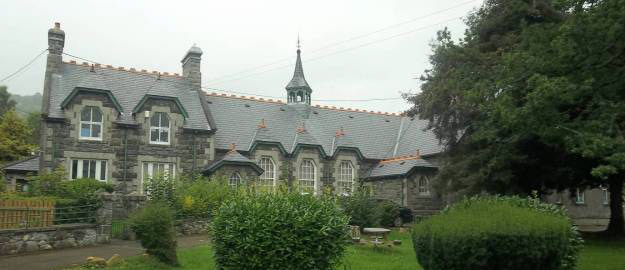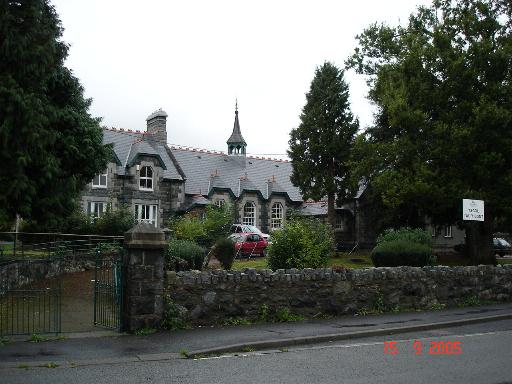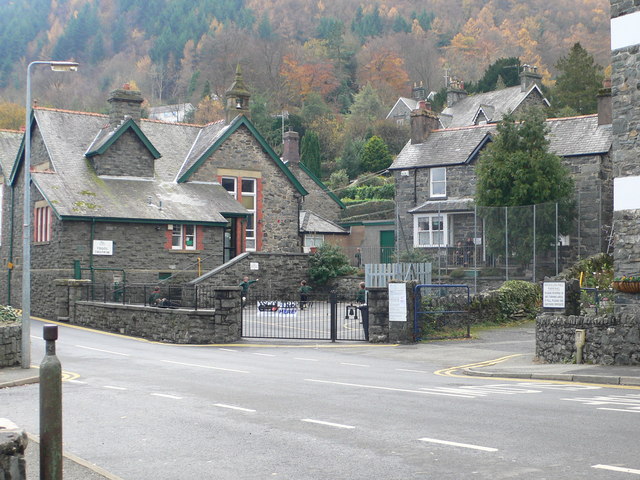2.1.8 Rural management and the challenges of continuity and change
Activity 1
Main question
How can governmental bodies (e.g. Conwy County Borough Council) respond to challenges regarding primary school provision, in light of a reduction in birth rates, the influence of migration amongst young people and the increase in house prices, as a result of second-home ownership ?
Questions
Describe the location of the villages of Dolgarrog, Tal y Bont and Trefriw using the map on Resource A only.
Compare the characteristics of the 3 primary schools that are being considered for a programme of modernisation.
Examine the reasons underlying the viewpoints presented in the ‘Objection report to the amalgamation of the three schools’ shown on Resource D?
After considering the cartographic and written information regarding the Option Appraisal for the modernisation of primary schools in the Caerhun and Trefriw area, to what extent do you agree with the Conwy County Borough Council that Option 1 is the best choice ?
-
Resource A
Map showing the location of Tal y Bont, Dolgarrog and Trefriw.
http://www.openstreetmap.org/#map=12/53.1753/-3.9321&layers=N -
Resource B
Conwy Primary Schools Modernisation Project
Option Appraisal for the Caerhun & Trefriw Area


Ysgol Trefriw (Trefriw School)
Copyright Conwy County Borough Council
Extracts from the report - Caerhun and Trefriw Area Profile
There are three primary schools covering the Caerhun and Trefriw area - Ysgol Dolgarrog, Ysgol Tal Y Bont and Ysgol Trefriw. All three schools are classed as Welsh Medium Primary Schools and all pupils are taught Welsh as a first language. Both wards (Caerhun and Trefriw) have an urban/rural classification of ‘Village, Hamlet & Isolated Dwellings’.
The combined population for both wards is 3198, containing a slightly higher proportion of people up to 65 years of age than the mean average for Conwy County; and a lower proportion of children aged 0-15.
The catchment area population of Ysgol Dolgarrog is 433 with 444 dwellings within 1 mile of the school.
There are 316 dwellings within 1 mile of Ysgol Tal Y Bont and a catchment area population of 1294.
For Ysgol Trefriw the catchment area population is 824 with 385 dwellings within 1 mile of the school.
Resource C
Profile of Ysgol Dolgarrog (Dolgarrog School)


Ysgol Dolgarrog (Dolgarrog School)
Copyright Conwy County Borough Council
Ysgol Dolgarrog is a Community Welsh medium Primary School for children aged between 3 and 11 years old. The school is located in the centre of the village of Dolgarrog in the Conwy Valley, serving the village and its rural catchment area. The school is a 2 storey building built in 1934, with an additional kitchen built in 1945.
Ysgol Dolgarrog teaching staff consists of a permanent Headteacher (with a teaching commitment that is at least 50%. There is also a full time teacher and 2 part time teachers, together with 2 teaching assistants, who provide additional support to the pupils, and 2 administrative support staff.
The average class size, according to the 2012 September Stats. Returns were 18 pupils, from a low of 13 pupils in one class to a high of 27 in another class.
In January 2012 there were 58 pupils attending Ysgol Dolgarrog, including 10 pupils attending the nursery part time. The current figure (2016) of 48 pupils who attend the school full time has remained relatively constant over the last 5 years with the full time pupil numbers staying between a low of 45 and a high of 48 pupils. This has meant that the percentage of unfilled places (excluding nursery pupils) has also remained at an average figure of 48% over the last 5 years.
Projected pupil numbers for Ysgol Dolgarrog show that there will be an anticipated rise of around 4 pupils by 2017.
The current deposit Conwy Local Development Plan (2007 – 2022) indicates that new housing sites will be developed within the Caerhun and Trefriw area, with intentions for the Ysgol Dolgarrog catchment area to accommodate a further 55 dwellings with a potential to yield an additional 17 primary school age pupils associated with these extra dwellings. This could potentially impact on the percentage of unfilled places, reducing the figure to around 23%.
Resource D
Profile of Ysgol Tal Y Bont (Tal y Bont School)


Ysgol Tal y Bont (Tal y Bont School)
Copyright Conwy County Borough Council
Ysgol Tal Y Bont is located in the village of Tal Y Bont, and is a Community Welsh medium Primary School for children aged between 3 and 11 years old. The school was built in 1925 and a kitchen extension was built in 1958. The pupils come from the village itself and the surrounding rural area.
The teaching staff at Ysgol Tal Y Bont includes an acting Headteacher and one other full time qualified teacher. To provide additional support to pupils there are also 2 teaching assistants and 2 special needs support staff.
The average class size according to the annual September 2012 Stats returns is 12.6 pupils, with a low of 11 in one class and a high of 14 in another.
As of January 2012 there were 38 full time pupils at Ysgol Tal Y Bont with no pupils attending the part time nursery class.
The number of full time pupils at the school has not changed dramatically in the past 5 years, with a low of 30 pupils and a high of 42.
The number of unfilled places (excluding nursery pupils) currently stands at 37% and has been as high as 54% in the last 5 years.
Projected pupil numbers suggest that over the next 5 years there will be a decrease in the number of pupils at Ysgol Tal Y Bont by a figure of around 15 pupils. This would see the percentage of unfilled places at the school rise to about 62% by 2017.
The current deposit Conwy Local Development Plan (2007-2022) indicates that the Ysgol Tal y Bont catchment area is likely to accommodate a further 2 dwellings with a potential for one additional primary school age pupil associated with these extra dwellings.

Source - http://www.geograph.org.uk/photo/53720
Photo of the school in 2007 © Copyright Dot Potter and licensed for reuse under this Creative Commons Licence.Resource E
Profile of Ysgol Trefriw (Trefriw School)

Ysgol Trefriw is situated on the main road in the middle of the village. It is a Community Welsh medium Primary School for children aged 3 to 11 years old serving the children of the village and also pupils from the surrounding rural area. The school was built in 1902.
The teaching staff comprises a permanent headteacher (who has a teaching commitment of between 50 and 100%) and two other part time qualified teachers. There are two teaching assistants as well as an administrative staff member.
According to the annual Statistics returns for September 2012 the average class size was 18.5, with 16 in one class and a maximum of 21 in another class.
In January 2012 there were 39 pupils attending Ysgol Trefriw, of whom three were attending the nursery part-time. Over the last five years the number of pupils has remained fairly constant, with the current figure of 36 pupils and a maximum of 41 pupils. The percentage of unfilled places (which excludes nursery pupils) is currently 51% . The projected number of pupils in Ysgol Trefriw indicates a decline, from the current pupil numbers, of about 10 pupils over the next five years. This would mean that the percentage of unfilled places would rise to around 64% by 2017.
The current deposit Conwy Local Development Plan (2007 – 2022) indicates that new housing sites will be developed within the Caerhun and Trefriw area. In the Trefriw ward and catchment area a further 17 dwellings could be accommodated and could potentially yield an additional 5 pupils. This could mean that the percentage of unfilled places at Ysgol Trefriw could be reduced to around 57% by 2017.

Source - http://www.geograph.org.uk/photo/617641
Photo of the school © Copyright Eirian Evans and licensed for reuse under this Creative Commons Licence.Resource F
4 Options were suggested for the future provision of primary education in the area.

Option 1 – closing the three schools in Dolgarrog , Tal y Bont and Trefriw and building a new school on one site. The new school would be lead by one headteacher and one governing body.
This is the preferred option of the County. This choice, however, was the least popular of the four amongst the pupils of the three schools and local residents. The importance and worth of a school to a community were clearly expressed in pupil workshops in each school and in stakeholder meetings. The feedback from the stakeholder meetings stressed the importance of a small rural school ethos in the centre of a community. It was also felt that small class sizes were advantageous to pupils. Further concerns were expressed regarding a loss of choice and loss of the Welsh language.
Option 1 was regarded as the best in terms of financial advantage. Having an Area School on one site would evidently help to reduce the number of empty places from the current percentage of 49% in the three schools to an anticipated 13% in 2018, if this option is chosen.
The Language Impact Assessment conducted as part of this report suggests that an amalgamated school would be advantageous to the preservation and promotion of the Welsh language. It would allow a joint governing body to draw up a policy which would develop the current good practice in Welsh first language teaching demonstrated in the 3 schools.
Option 1 does have the highest initial Capital costs as it involves a new build scheme. However it would produce the highest savings in terms of the School Revenue Allocation with a saving of around £148,000. The NPV appraisal (which looks at running costs over a 30 year period) is lower than it would be for Options 2 or 4, showing that an Area school would make long term savings.
Option 2 – the three schools would keep their current identity, each with their own headteacher and governing body – that is, the current situation.
In terms of the Community Impact Assessment and the ‘views of those most directly affected’, this was the favoured option. Both the community and the children indicated that they would like to keep the schools as they are.
The Community Impact Assessment makes the point that the communities of Dolgarrog, and especially Tal y Bont & Trefriw would be at a disadvantage if they lost their schools as both the schools and communities currently make use of facilities provided by and within the school and community.
This option would not tackle the issue of ‘unfilled places’, meaning that by 2018 there could potentially be an average of 52% unfilled places across the three schools, which is significantly higher than the ideal of 10% surplus places in a school.
The capital cost for the scheme of maintaining the 3 current schools is only slightly less than the new build option, as all schools would require considerable works in order to bring them up to 21st Century Schools standards. It is suggested that this option would be the most costly in the long term and would not make any impact on the number of unfilled places there are in all of the 3 schools.
Option 3 – this choice would follow the same format as ‘Option 1’, but a new school on one site would be achieved by re-modelling Dolgarrog School, rather than building a brand new school.
As with Option 1, an Area School on 1 Site would significantly help to reduce the number unfilled places and would benefit from one Governing Body having a mutual way forward in terms of their Welsh Language provision and the continuing development of educational standards.
This option differs from Option 1 in terms of Buildings ‘Fit for Purpose’ as the remodelling of the Ysgol Dolgarrog site would not have the same design standards that a new build would offer. There would also be fewer savings to be made in the School Revenue Allocation compared to Option 1 with around £137,000 savings to be made.
This scheme would fully satisfy the 21st Century Schools agenda and scores the lowest in terms of the capital costs and NPV value, again suggesting that an Area School is the best way forward for the future.
Option 4 – this would involve closing the three existing schools. They would then be reopened as an Area School on the three current sites. The new Area School would have a new name and operate with one headteacher and one governing body over the three sites.
As with Option 2, there would be no change/impact regarding any issues on Transport, Welsh Language or unfilled places, as the sites would continue to stay where they are with no significant change for pupils and their families; and the amount of unfilled places would continue to be significantly higher than the ideal, possibly increasing even further.
This option was also not a popular choice with the children during the workshop sessions, mainly due to the idea of sharing a Headteacher. There would not be much difference from Option 2 in terms of the Buildings ‘Fit for Purpose’ appraisal. There would be significant capital costs in order to bring the three schools up to a ‘fit for purpose’ standard, with less savings to be made in the School Revenue Allocation in comparison with an Area School on 1 Site (Options 1 or 3). Also the NPV value is the second highest across the options, implying that the running of 3 separate sites will continue to be the least cost effective way forward.
Resource G



